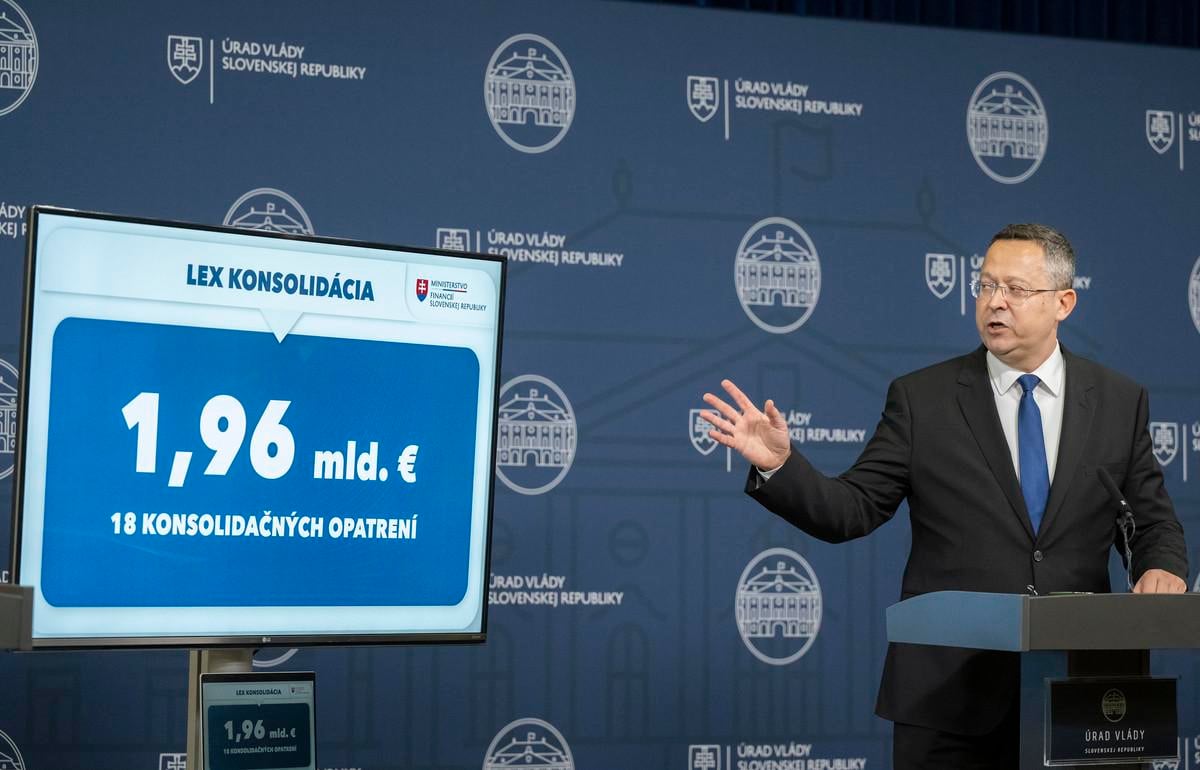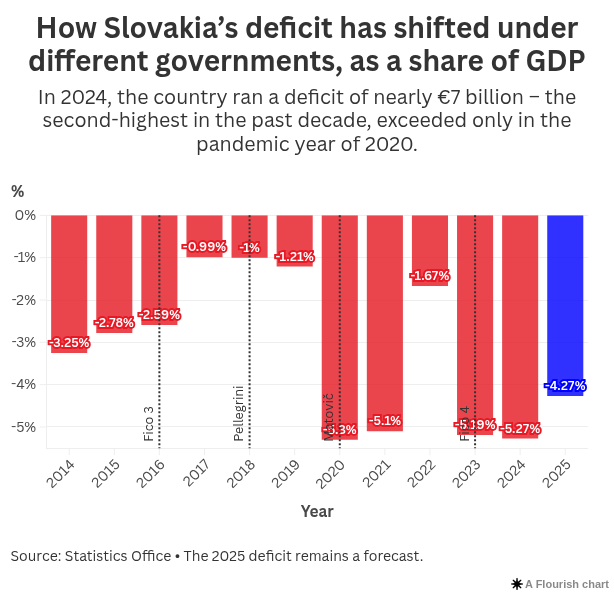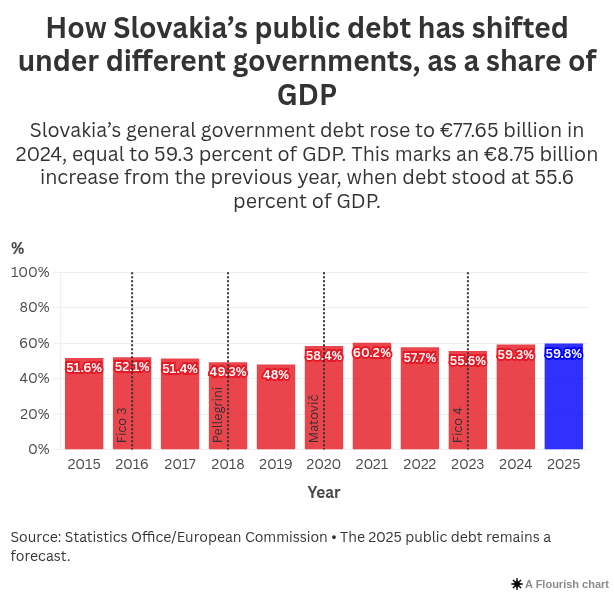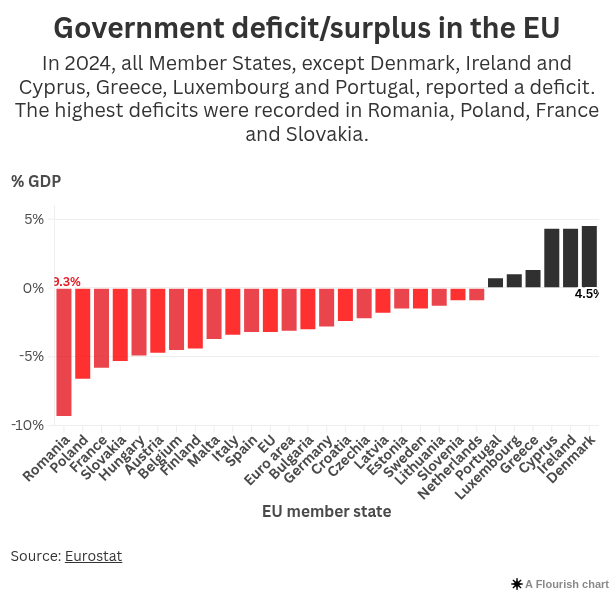Slovakia ended 2024 with a public finance deficit of 5.3 percent of GDP – lower than feared, but still among the worst in the European Union and well above the bloc’s 3 percent ceiling. With debt now nearing 60 percent of GDP, the country’s long-term fiscal sustainability is in serious question, according to national watchdogs.
When Prime Minister Robert Fico returned to power in late 2023, his government moved swiftly to plug the gaping hole in public finances – a €6.4 billion deficit left in the wake of successive crises and chaotic governance under the previous three administrations. Fico’s coalition raised health insurance contributions, introduced new taxes (including one on banks), and slashed contributions to the second pension pillar. Even the 1st of September public holiday was abolished to boost productivity.
But these austerity-style measures were quickly offset by costly giveaways. Universal energy subsidies and full-scale 13th pension payments significantly worsened the budget’s structural health – a key indicator of a country’s ability to manage its debt without one-off fixes.
The result? Slovakia’s deficit edged up from 5.19 percent of GDP in 2023 to 5.27 percent last year, despite efforts to bring it down. In nominal terms, the country ran a deficit of nearly €7 billion – the second-highest in the past decade, exceeded only in the pandemic year of 2020. On a per capita basis, that’s roughly €1,278 per Slovak.
Crucially, the National Bank of Slovakia (NBS) and the Council for Budget Responsibility (RRZ), both non-partisan institutions, say these figures show that last year brought “no improvement” in the long-term outlook. The structural deficit – the part of the deficit that persists even when the economy is strong – rose by 0.9 percentage points to 4.2 percent of GDP.
This is alarming because temporary savings, such as the delayed delivery of military equipment which reduced 2024 defence spending by €1 billion, will reverse in the coming years.
“Consolidation must continue, and be more focused,” said Ján Tóth, the RRZ’s chair.
Meanwhile, public debt jumped from 55.6 to 59.3 percent of GDP, crossing the highest “sanction threshold” of Slovakia’s constitutional debt brake, which is meant to enforce fiscal discipline. Slovakia has never run a balanced or surplus budget in its modern history.
What drove the worsening outlook? Most notably, energy subsidies cost around €1.2 billion, while new revenue streams – such as increased healthcare contributions – failed to make up the gap. A sharp rise in healthcare spending, weak tax collection, one-off bonuses for selected public sector employees – including soldiers, teachers and police officers – and increased social spending, particularly on pensions, added to the pressure.
Some positive contributions came from improved management by local governments, public institutions and state-owned firms, as well as higher-than-expected dividends and interest income. But these were not enough to shift the structural trajectory.
To meet EU rules and cut the deficit below 3 percent by 2027, the government must find an extra €3.1 billion – either through savings or new revenue. To erase the deficit altogether, the figure rises to around €6 billion.
Fico’s finance minister, Ladislav Kamenický, has already enacted a second consolidation package, including a hike in VAT to 23 percent and a new financial transaction tax. A third package worth €2 billion is now being prepared, targeting property owners and the gambling sector, though few details have been made public.
Analysts have welcomed signs that the government is turning its attention to the spending side of the ledger. But they warn that much tougher decisions lie ahead. “The government must focus on improving spending efficiency and consider higher environmental and wealth taxes,” said Matej Horňák, an analyst at Slovenská sporiteľňa.
So far, however, the administration has shown a tendency to mix temporary fixes with permanent giveaways. In 2024 alone, it established a new Sport and Tourism Ministry, formalised full 13th pensions at a cost of over €800 million, and increased healthcare spending again. These choices, the budget council warns, risk undoing the modest gains made through fiscal tightening.
According to the European Commission, Slovakia has the least sustainable public finances in the European Union.
After Easter, Eurostat published updated comparative debt and deficit figures across the European Union – and the news for Slovakia was grim.



 Finance Minister Ladislav Kamenický (Smer) speaks about the consolidation of public finances during a press conference on 4 December 2023 in Bratislava. (source: TASR - Martin Baumann)
Finance Minister Ladislav Kamenický (Smer) speaks about the consolidation of public finances during a press conference on 4 December 2023 in Bratislava. (source: TASR - Martin Baumann)


 Debt Sustainability Monitor 2024 (source: European Commission)
Debt Sustainability Monitor 2024 (source: European Commission)
